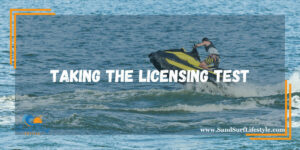If you’ve ever dreamt of gliding across the open water, the wind in your hair, and the thrill of adventure coursing through your veins, then owning and operating a jet ski might be the perfect hobby for you. However, before you can embark on aquatic adventures, it’s essential to ensure safety for yourself and others. Obtaining a jet ski license is a crucial step in this journey.
Understanding the Necessity of a Jet Ski License

A jet ski license isn’t just a bureaucratic hurdle; it’s a fundamental necessity to guarantee the safety and well-being of everyone enjoying waterways. Analogous to a driver’s license for automobiles, it establishes your competence and knowledge in operating a jet ski, an exhilarating but potentially hazardous watercraft.
In many regions, obtaining a jet ski license is mandated by law. This legal requirement aims to prevent accidents, minimize risks, and maintain order in waterborne activities. It sets a baseline standard of competency for operators, covering essential aspects like safety protocols, navigation rules, and emergency procedures.
Moreover, a jet ski license is a tool to foster responsible water recreation. By ensuring that operators have the requisite skills and understanding, it reduces the likelihood of accidents, collisions, or reckless behavior on the water. In essence, it’s a means to create a safer and more enjoyable environment for all water enthusiasts, making it a vital prerequisite before venturing into the world of jet skiing.
To learn more about jet skiing and legal requirements, check out this article.
Check Local Regulations
The first step in the process of getting your jet ski license is to research and understand the specific regulations in your area. Rules and requirements can vary significantly from one location to another, so it’s essential to be aware of what applies to your situation.
1. Contact Your Local Authorities
Initiating the process of obtaining a jet ski license begins with reaching out to your local boating or watercraft authority. This governing body may take the form of a state agency, city department, or a specialized marine division. They are the primary source of information regarding the entire licensing procedure. Expect to receive detailed guidance on what steps to follow, which documents are necessary, associated fees, and, crucially, specific regulations that govern jet ski operations in your area. Their expertise ensures you’re well-informed and in compliance with local laws.
2. Age Requirements
Age prerequisites for operating a jet ski exhibit variability among locations. While in many places, the legal minimum age to operate a jet ski is 16 years old, this criterion isn’t universal. Local authorities might establish different age limits, so consulting with them is essential. Age restrictions aim to ensure that operators possess the maturity and responsibility required for safe jet ski operation, emphasizing the importance of adhering to regional rules.
3. Educational Requirements
In certain regions, the path to obtaining a jet ski license includes the mandatory completion of a boating safety course. These courses delve into topics encompassing navigation techniques, safety protocols, and familiarity with local waterway regulations. Even if not compulsory in your area, enrolling in such a course is a prudent decision. These courses provide invaluable knowledge and skills that significantly boost your confidence as a responsible jet ski operator, enhancing overall safety.
4. Study the Rulebook
Local authorities often furnish rulebooks or handbooks explicitly delineating watercraft regulations applicable to your area. These resources serve as comprehensive guides to understanding the nuances of jet ski operation. From navigating waterways to adhering to safety protocols, these documents cover essential dos and don’ts. It’s paramount to allocate dedicated time to thoroughly study these materials to ensure you’re well-prepared and informed.
5. Gather Required Documents
To initiate the jet ski licensing process, you must assemble specific documents. Typically, these include proof of identity, validating your eligibility for the license, and proof of residency, confirming your local ties. Additionally, any certificates of completion from safety courses should be in order. Ensuring all paperwork is meticulously organized and available is pivotal to a smooth application process.
6. Pay the Fees
Acquiring a jet ski license invariably incurs associated fees, the extent of which hinges on your geographical location. These fees cover administrative costs and contribute to the upkeep of safety and regulatory systems. It’s imperative to be financially prepared to cover these costs as they represent a crucial aspect of the licensing procedure. Being financially ready ensures that there are no unexpected hurdles along the path to your jet ski license.
Practical Skills and Training
Once you’ve sorted out the legal requirements and paperwork, it’s time to focus on developing the practical skills necessary for operating a jet ski safely and confidently.
1. Jet Ski Familiarization
Before embarking on your jet ski adventure, it’s imperative to acquaint yourself with the nuances of your specific jet ski model. Take the time to understand the intricacies of the controls, get well-acquainted with safety features, and memorize emergency shut-off procedures. This level of familiarity ensures that you’re not just a passenger on the watercraft but its capable commander. Being able to effortlessly manipulate the controls and respond to emergencies is essential for safe and enjoyable jet skiing.
2. Safety Gear
Safety is paramount when jet skiing, and investing in the right safety gear is non-negotiable. At the forefront of this gear is a properly fitted life jacket that could mean the difference between life and death in the event of an accident. Equally crucial are accessories like a whistle or horn to signal for help and protective eyewear to shield your eyes from water splashes and glare. Wearing this safety gear isn’t just a suggestion; it’s a fundamental requirement to ensure your personal safety while operating a jet ski.
3. On-Water Training
Whether you’re a novice or looking to refine your jet skiing skills, enrolling in an on-water training course can be immensely beneficial. These courses are typically led by experienced instructors who impart valuable knowledge about proper riding techniques, effective navigation skills, and crucial emergency procedures. Practical training sessions provide an opportunity to translate theory into real-world experience, ultimately boosting your confidence as a jet ski operator and, most importantly, making you a safer and more adept rider.
4. Start in Controlled Environments
For those new to jet skiing, it’s sage advice to begin your journey in controlled environments. Opt for calm, placid waters like a lake or bay for your initial rides. These settings offer a forgiving learning environment where you can acclimate to the feel of the jet ski and practice fundamental maneuvers without the complexities of challenging waters. As your skills and confidence grow, you can gradually graduate to more adventurous water conditions.
5. Learn Navigation Rules
Mastering the rules of the water is as pivotal as knowing the rules of the road. Familiarize yourself with safe navigation practices, including how to navigate around other vessels, right-of-way rules to avoid collisions and awareness of restricted zones. Understanding and adhering to these rules not only ensures your safety but also contributes to harmonious coexistence with other waterway users. It’s an essential part of responsible jet skiing that promotes the well-being of everyone sharing the water.
Taking the Licensing Test

With your knowledge and skills honed, it’s time to prepare for and take the jet ski licensing test. This test typically assesses your understanding of local waterway regulations, safety procedures, and your ability to operate the jet ski safely.
1. Written Test
The written portion of the jet ski licensing test is a critical assessment of your knowledge concerning watercraft safety and regulations. It covers a wide array of topics, including navigation aids, right-of-way rules, emergency procedures, and local waterway regulations. To excel in this segment, thorough preparation is paramount. Delve into your rulebook and revisit your safety course materials, absorbing key concepts and details. By honing your theoretical understanding, you’ll be well-equipped to tackle questions that assess your grasp of the fundamental principles of safe jet ski operation.
2. Practical Skills Test
In select regions, the jet ski licensing process includes a practical skills test. This evaluation entails demonstrating your ability to apply theoretical knowledge in real-world scenarios. You may be tasked with executing maneuvers like turns, stops, and emergency stops. Your performance during this phase should exemplify your proficiency in handling a jet ski safely and effectively. Be ready to showcase your skills, employing precise control and sound judgment to navigate various challenges presented during the test.
3. Study and Practice
Preparation is the bedrock of success in the jet ski licensing process. Dedicate ample time before the test date to review and reinforce your understanding. This entails revisiting all the materials you’ve acquired, both from your safety course and independent study. If there’s a practical skills portion, practice the required maneuvers rigorously until you feel confident in your abilities. The combination of theoretical knowledge and practical proficiency is the key to passing the test with flying colors.
4. Test Day
On the day of the test, a punctual arrival is crucial. Ensure you have all required documentation in hand, including identification, proof of residency, and certificates from safety courses. Dress appropriately in your safety gear, ready to meet the testing conditions. Being organized and well-prepared on the test day sets the stage for a smooth and efficient examination process.
5. Stay Calm and Focused
As you undertake the jet ski licensing test, maintain composure and focus. Approach written questions with care, providing well-considered responses that reflect your knowledge. If there’s a practical skills component, execute maneuvers confidently, drawing upon your training and practice. Remember the core principles of safety and best practices you’ve learned throughout your preparation, integrating them into your performance during the test.
6. Post-Test Evaluation
After completing the test, you might need to exercise patience as you await the results. If you pass, it’s a significant milestone, bringing you closer to the privilege of legally operating your jet ski. In the event you don’t pass, don’t be disheartened. Most regions permit test retakes after additional preparation. Use the experience as a valuable learning opportunity, identifying areas of improvement, and redoubling your efforts for a successful retest. Persistence and dedication will ultimately lead to your well-deserved jet ski license.
License Issuance
Once you’ve successfully passed the jet ski licensing test, you’re almost there. The final step is obtaining your physical license.
1. Wait for Processing
After completing the jet ski licensing test, the next step is to wait for the processing of your test results and the verification of your documentation. This processing period can vary depending on your local authorities and their workload. It’s important to exercise patience during this phase, understanding that thorough examination ensures the integrity of the licensing system. Be prepared for potential delays and avoid undue stress while awaiting the confirmation of your eligibility to operate a jet ski legally.
2. Receive Your License
Once your application has been processed and approved, you will be issued a physical copy of your jet ski license. This document serves as the official proof that you have met all the requirements and are licensed to operate a jet ski within your area. Safeguard this license by keeping it in a secure place, and remember to carry it with you whenever you embark on a jet skiing adventure. It’s your key to legally enjoying this thrilling water activity.
3. Renewal and Continuing Education
Jet ski licenses typically come with expiration dates, indicating the need for periodic renewal. The frequency of renewal can vary, so it’s essential to keep track of your license’s expiration date and follow your local renewal process to maintain your legal status. Additionally, consider engaging in continuing education by taking advanced safety courses. These courses not only enhance your skills but also reinforce your commitment to responsible jet skiing. Investing in ongoing education ensures that you remain a safe and conscientious jet ski operator, contributing to your enjoyment and the safety of others on the water.
For more information about jet ski licensing, check out this article.
Conclusion
Obtaining a jet ski license is a crucial step in enjoying this exciting water sport safely and responsibly. By understanding your local regulations, gaining practical skills, and passing the licensing test, you can embark on thrilling jet ski adventures while ensuring the safety of yourself and others on the water. Remember that safety should always be a top priority, and ongoing education and responsible riding are key to enjoying this thrilling hobby to the fullest. Now, armed with this guide, you’re ready to take the plunge and begin your jet ski journey with confidence.
Please note that the contents of this blog are for informational and entertainment purposes only and should not be construed as legal advice. Any action taken based on the information provided in this blog is solely at your own risk. Additionally, all images used in this blog are generated under the CC0 license of Creative Commons, which means they are free to use for any purpose without attribution.

